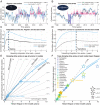Coastal upwelling drives ecosystem temporal variability from the surface to the abyssal seafloor
- PMID: 36947518
- PMCID: PMC10068760
- DOI: 10.1073/pnas.2214567120
Coastal upwelling drives ecosystem temporal variability from the surface to the abyssal seafloor
Abstract
Long-term biological time series that monitor ecosystems across the ocean's full water column are extremely rare. As a result, classic paradigms are yet to be tested. One such paradigm is that variations in coastal upwelling drive changes in marine ecosystems throughout the water column. We examine this hypothesis by using data from three multidecadal time series spanning surface (0 m), midwater (200 to 1,000 m), and benthic (~4,000 m) habitats in the central California Current Upwelling System. Data include microscopic counts of surface plankton, video quantification of midwater animals, and imaging of benthic seafloor invertebrates. Taxon-specific plankton biomass and midwater and benthic animal densities were separately analyzed with principal component analysis. Within each community, the first mode of variability corresponds to most taxa increasing and decreasing over time, capturing seasonal surface blooms and lower-frequency midwater and benthic variability. When compared to local wind-driven upwelling variability, each community correlates to changes in upwelling damped over distinct timescales. This suggests that periods of high upwelling favor increase in organism biomass or density from the surface ocean through the midwater down to the abyssal seafloor. These connections most likely occur directly via changes in primary production and vertical carbon flux, and to a lesser extent indirectly via other oceanic changes. The timescales over which species respond to upwelling are taxon-specific and are likely linked to the longevity of phytoplankton blooms (surface) and of animal life (midwater and benthos), which dictate how long upwelling-driven changes persist within each community.
Keywords: California Current; animal lifespan; coastal upwelling; deep sea; ecosystem variability.
Conflict of interest statement
The authors declare no competing interest.
Figures





References
-
- Borja A., Grand challenges in marine ecosystems ecology. Front. Mar. Sci. 1, 1 (2014), 10.3389/fmars.2014.00001. - DOI
-
- Benway H. M., et al. , Ocean time series observations of changing marine ecosystems: An era of integration, synthesis, and societal applications. Front. Mar. Sci. 6, 393 (2019), 10.3389/fmars.2019.00393. - DOI
-
- Smith K. L. Jr., et al., Navigating the uncertain future of global oceanic time series. Eos 96 (2015), 10.1029/2015EO038095. - DOI
Publication types
MeSH terms
Substances
LinkOut - more resources
Full Text Sources
Research Materials

